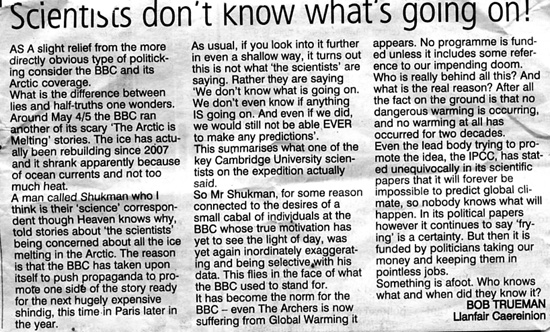
It's a funny thing. One of the most viral news items concerning the UK General Election on May 7th 2015 came from my constituency of Montgomeryshire. Apparently, someone took the time and trouble to draw a remarkably detailed sketch of a penis in the box that they would have otherwise crossed had they been voting for the incumbent Conservative MP, Glyn Davies. In other headlines, three high-profile party leaders resigned within an hour of one another the following morning but everybody turned over and went back to sleep on that one.
I hasten to add that the artwork had nothing to do with me. I voted for one of the other guys – tactically, which in the context of Glyn's significantly increased majority turned out to be a wasted vote. I should have voted with my heart – for the Greens or Plaid Cymru. Unlike the other parties, at least I can state that I have met the leaders of the latter two in person and have found them to be – well, real, passionate and principled people, as opposed to the used car salesmen stuffed into suits to look “respectable”, that tends to be the norm over here.
So, what has this to do with climate change, readers may well be asking? Quite a lot in fact. What troubles me about the outcome of Election '15 is that voters, like turkeys vaguely approving the advent of Christmas, seem to have voted for more Business As Usual. But they have done so in a political atmosphere so clouded with media-served misinformation that it is hard to know where to start with the debunking. So let's put UK politics to one side now and stick to our speciality: dealing with another channel of misinformation, that related to global warming. Take a look at this letter, from the latest issue of the County Times, a weekly newspaper that covers Powys, the larger local authority area of which Montgomeryshire is a part:

Just where did the writer get these ideas from? The first half of the letter is about a part of the globe that is warming so quickly compared to anywhere else that the phenomenon even has its own special term, Arctic amplification. Take the first major error, column one, paragraph two, line five. Has the writer forgotten or not realised that the Arctic sea-ice minimum record was utterly smashed in 2012? The minimum then was 3.4 million km2, against a 2007 value of 4.28 million km2 and a 1979-2000 average of 6.75 million km2. Nobody expected year-on-year record meltdowns: it hits a record, then doesn't for a few years, then the record is broken once again – it's a bit like the surface air temperature record in that respect. In this age where people seem to expect instant results, global warming goes against that: it is a slow, stepwise process. This animated graph, by Dana, spells it out clearly:
above: September Arctic sea ice extent data since 1980 from the National Snow and Ice Data Center (blue diamonds). "Recovery" years, meaning years when the sea ice extent is greater than the previous year, are highlighted in red. Every time they occur, the usual suspects are out and about claiming them to be "proof" that global warming has stopped. But wait for the trend-line!
The writer then goes on to bemoan that The Archers (a popular radio soap-opera also known as “an everyday story about country folk”) is now suffering from Global Warming. This, I make an educated guess because I listen to it, must be a comment about the fictional village of Ambridge recently getting a heavy dose of what the good people of the Somerset Levels had to endure for real for months on end in winter 2013-14: water, a great deal of it and all in the wrong places. The writer also states that "no warming at all has occurred for two decades". That makes it, unless I've really flunked my maths, no warming since 1995. Hmm. 1998, 2005, 2010 and the record-breaking 2014 were the hottest years on record.
But such sets of statements raise a serious question: how can people end up believing and repeating such clearly erroneous things? The correspondent in the above letter would only have to have searched a little online to have located full Arctic sea ice datasets on extent, area and volume. They would then have known that it has not recovered since 2007: the long-term trend is very much downwards and in addition February 2015 saw the lowest Arctic sea-ice maximum of the satellite record.
It's too early to call this year's Arctic sea-ice minimum, of course, but the word “recovery” is only too readily bandied-about by characters like David Rose who is fond of getting paid to write climate change misinformation in the UK tabloid, the Daily Mail. It's on a level with the utter junk about the UK's weather that makes up Daily Express (another UK tabloid) front pages in between articles about rising house prices, Princess Diana and miracle cures for cancer. In the UK, George Monbiot and I have been campaigning against such nonsense for some time, most recently here and here, but the tidal flow of complete guff continues unabated. And when people are repeatedly misinformed about a topic, they end up bereft of the tools with which to come to an evidence-based conclusion. How can they then make the best and most logical decisions? That's bad enough in party politics. In the field of energy and climate and the long-term future of Wales (or for that matter, Planet Earth), it is far more serious.
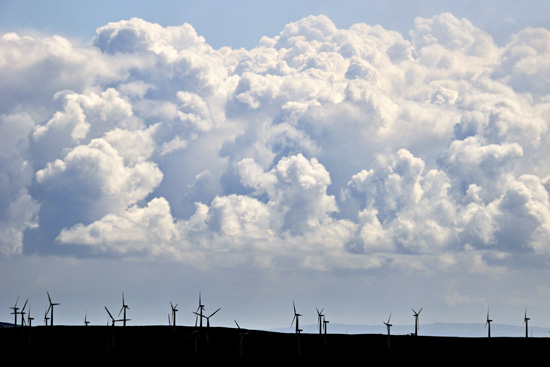
above: spoiling the view? Wind turbines in the Montgomeryshire uplands. Photo: author.
Montgomeryshire is an interesting constituency in more ways than one, and the same can be said for the bigger overall county of Powys. With extensive uplands, exposed to the prevailing sou-westerlies that feed in off the Atlantic, Powys has attracted a lot of investment in wind energy. It has also attracted a lot of people from the cities, keen to invest in property and live out retirement in the countryside. A proportion of them - and some local people - don't like looking at wind turbines. And there is the crunch-point. David Cameron recently saw it and swiftly took advantage. During the election campaign, he said the following with respect to Powys:
“You would have to ask the environment secretary who took that decision and that was a decision for him. However, I want to make it clear that if there is a Conservative Government in place we will remove all subsidy for on-shore wind and local people should have a greater say. Frankly I think we have got enough on-shore wind and we have enough to be going on with, almost 10 per cent of our electricity needs, and I think we should give local people a say if they want to block these sorts of projects. The only way to stop more on-shore wind is to vote Conservative there is no other party with this policy. We are saying very clearly we would remove the subsidy and give local people the power to say yes or no. This would end the growth of on-shore wind and if that’s what you care about you must vote Conservative.”
And the rest, as they say, is history. But there's a minor rainbow under this dark cloud in that Cameron has appointed Amber Rudd as Energy and Climate Change Secretary in his new Cabinet. Liz Truss remains in her post as Secretary of State for the Environment, Food and Rural Affairs. This is to be applauded: regular readers will recall that one of the previous Environment Secretaries serving under Cameron sounded as though he was on loan from the so-called Global Warming Policy Foundation (see for example our debunking of him here). Neither Rudd nor Truss is a climate change denier – far from it, and I wish them well in their posts. But I'd better come to the main point.
People who object to wind-farms tend to do so because they perceive that they will spoil the view and/or lower property prices. They seem to think that somebody else should have to look at the means of electricity generation whilst they merely use the stuff as they see fit. I have some news for such people that is rather more significant in the long term. If any of them should read this, I'll start with a question. What makes the ancient market-town of Machynlleth (my hometown and a community that I love) unique in Powys?
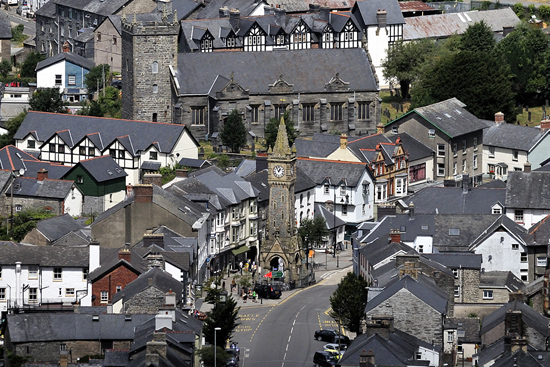
above: the historic market town of Machynlleth. Photo: author.
The answer is that in the case of unmitigated climate change, it is the only town in Powys that will be wiped off the map. I mean that quite literally. Not in my lifetime, but the coming together of the circumstances that will allow it to happen is happening on our watch and thus far little has been accomplished to put a stop to that. People, it seems, prefer to complain about wind turbines spoiling the view. But the nitty-gritty is as follows. Much of Machynlleth stands at between 6 and 25 metres above sea-level. That's mean sea-level of course, not taking into account that the local tidal range varies between 3.4 metres at high water on the smallest neap tides to 5.7 metres at high water on the biggest spring tides. Storm surges can also add a metre or two of extra water. We know that ice-sheet meltdown is accelerating, especially in Western Antarctica, and it will be difficult to stop it any time soon. This is because inertia in the climate system and the carbon cycle means that the global mean temperature can only decline slowly (on a millennial scale) even after greenhouse gas emissions have ceased. In turn, that raises the question of how much sea-level rise can be expected as a consequence of those raised temperatures.
Levermann et al (2013), looking at past warm periods during the Pliocene and the Quaternary, including the last interglacial, have calculated that for every degree Celsius of warming above preindustrial levels, 2.3 metres of sea-level rise can be expected over the next 2000 years. The pace of that rise is uncertain: in the 20th century, with 0.8C of global warming, 0.2m of sea-level rise occurred, mainly due to loss of glaciers and thermal expansion of sea water with parts of the polar ice-caps playing an ever-increasing role. On the basis of Levermann et al, getting on for 1.65 metres of additional sea-level rise can be expected in the coming decades of this and the next century due just to the warming to date. The "safe" warming target of 2C above preindustrial levels produces a total of 4.6 metres of sea level rise, or 4.4 metres above present levels. Failure to contain temperatures at that level brings an increasingly widespread risk: a warming of 4C brings with it 9.2 metres of sea level rise and so on.
It's also worth bearing in mind that the process doesn't simply stop after the 2000 year period under consideration. That's because of a parameter known as the "ice threshold" which is the level of atmospheric carbon dioxide below which ice-caps can start to form on a non-glaciated, cooling earth, as was the case in the mid-Cenozoic. Royer (2006) places the ice threshold at around 500ppm carbon dioxide - with levels consistently above that, the planet simply deglaciates over the next few thousand years with tens of metres of sea level rise as a consequence.
The current rate of sea-level rise is just under 3 millimetres per year (or 0.3 metres per century - and accelerating), but we know that during other deglaciation events, typical rates of 1-1.5 centimetres a year and exceptionally (as in the case of Meltwater Pulse 1A) 5 centimetres a year have occurred (see for example Foster and Rohling, 2013). That's typically 1-1.5 metres a century, and exceptionally 5 metres a century, or 20 metres in 400 years. Delivery time uncertain, but delivery certain, as one of my colleagues recently put it.
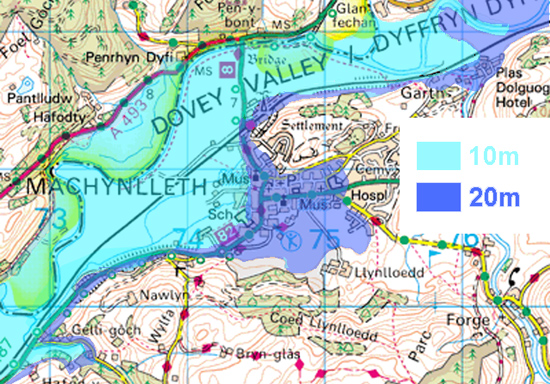
above: Machynlleth, after 10 m and 20 m of sea-level rise. Grid squares = 1km
Yes, we (well, some of us) know what is possible. Whether an extreme scenario like Meltwater Pulse 1A occurs or whether the process takes many more centuries as suggested by Levermann et al is beside the point. With unmitigated climate change, Machynlleth will be wiped off the map either way. And long before then, low-lying coastal settlements will be under aggravated threat. Down at the open coast is Borth, the beach-side onetime fishing village, now popular holiday destination. It is right in the firing line of sea-level rise, as are dozens of similar towns and villages. Some places have had worse news. It has already been decided that the village of Fairbourne, up the coast to my northwest, will “enter into managed retreat in 2025”. Fairbourne is one of around 50 of the coastal communities of Wales that have been similarly listed. They are to be abandoned in the face of sea-level rise. Now that's what I call a spoiled view.
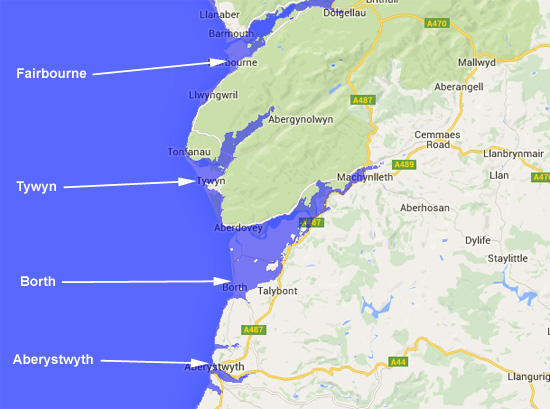
above: the effects of ten metres of sea-level rise on the Cardigan Bay coast of Mid-Wales.
The issue is, of course, not unique to Wales. A glaring example is Florida (below - from NASA Earth Observatory). The right-hand graphic shows the amount of land that will be wiped off the map with 5m (darker blue) and 10m (lighter blue) of sea-level rise. A lot of Florida is less than sixty metres above sea-level. You'd think they'd be spearheading the campaign to decarbonise. An existential threat not just to a few coastal towns but to a whole State. The official policy response? Ban all public servants from using the terms "global warming", "climate change" and "sea-level rise" in any official communications.

It really makes one wonder what some people have voted for.
Posted by John Mason on Monday, 25 May, 2015
 |
The Skeptical Science website by Skeptical Science is licensed under a Creative Commons Attribution 3.0 Unported License. |